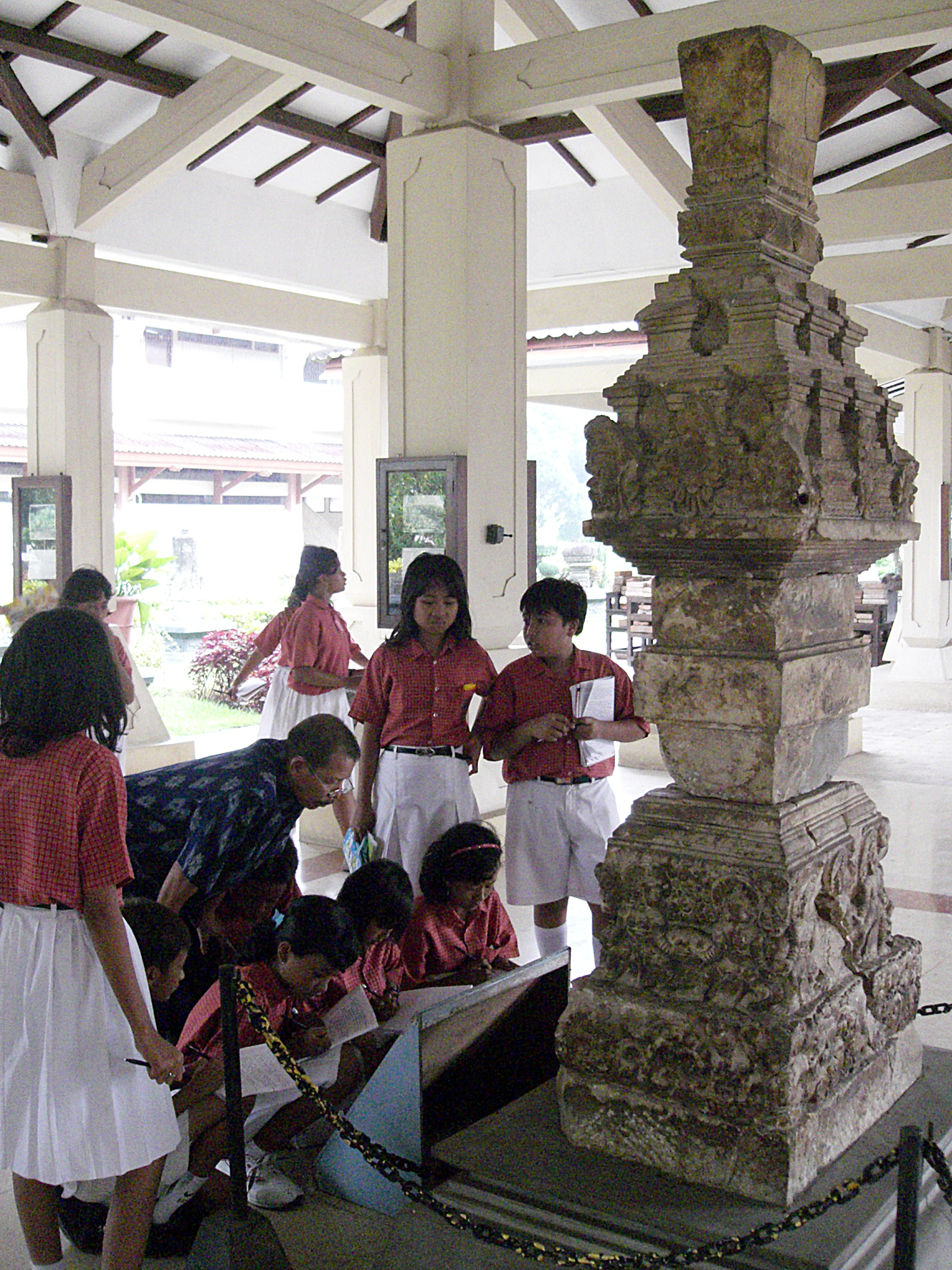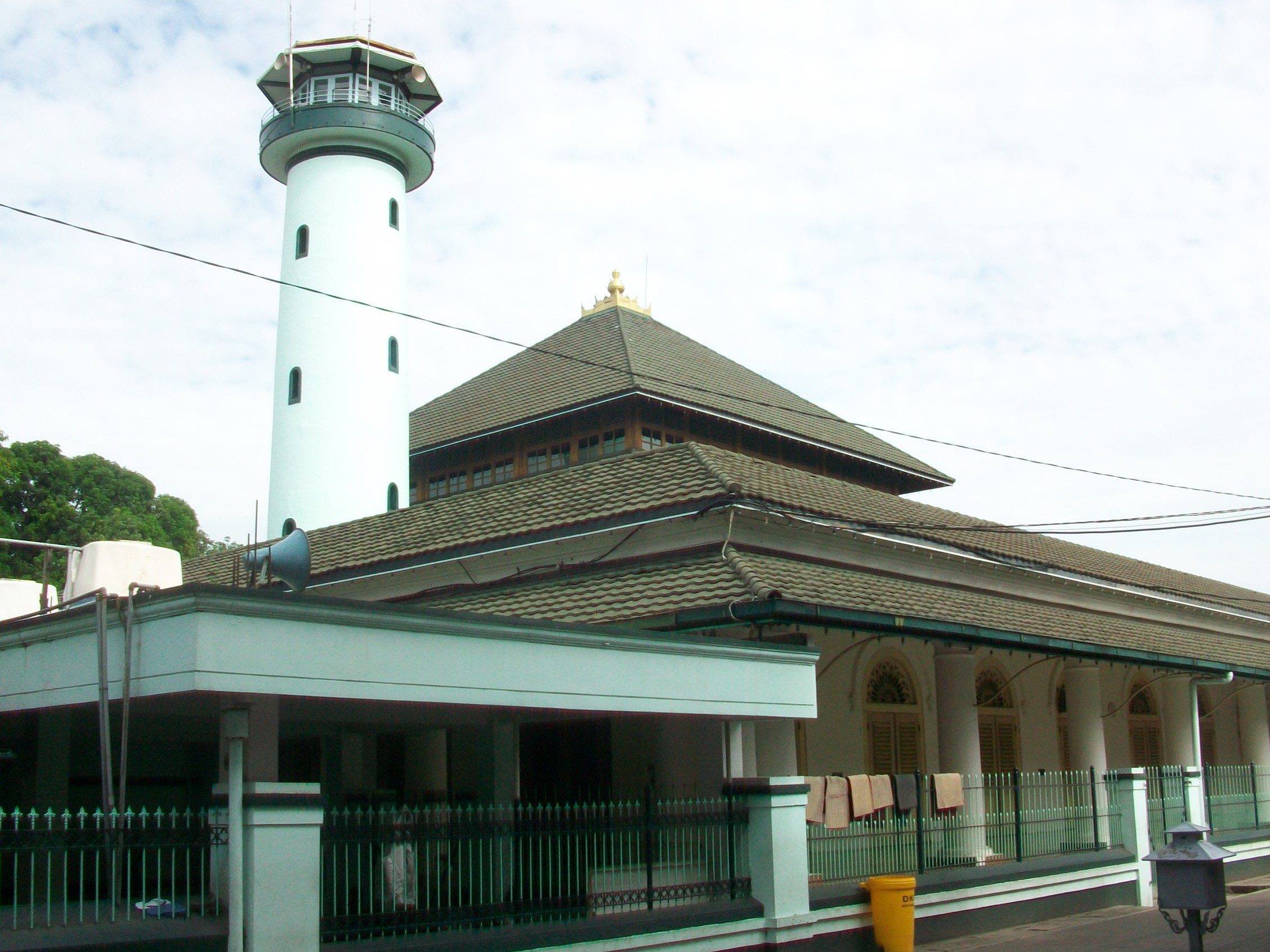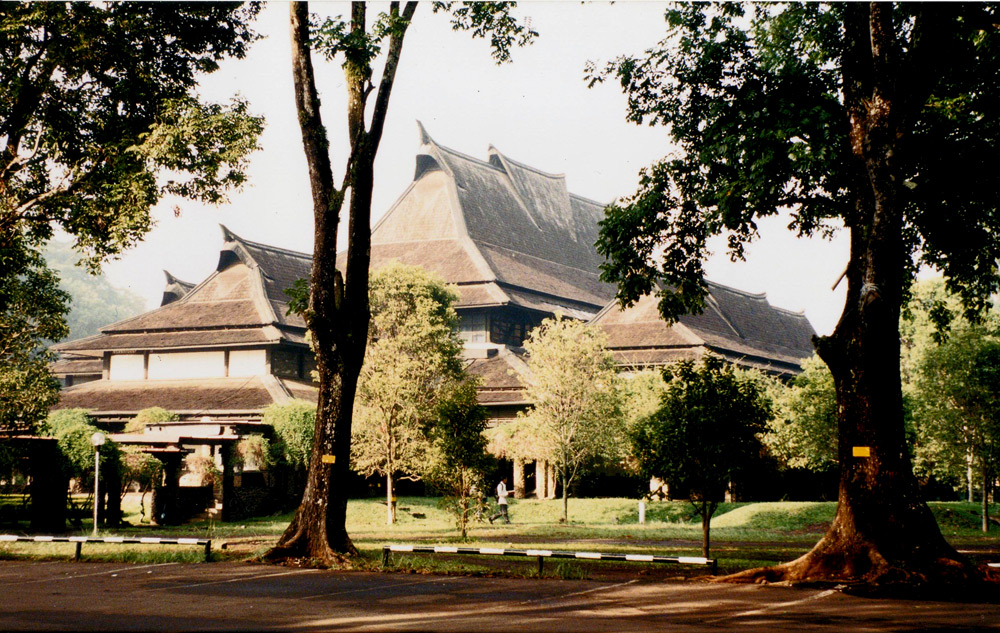|
Trowulan
Trowulan is an archaeological site in Trowulan (subdistrict), Trowulan Subdistrict, Mojokerto Regency, in the Indonesian province of East Java. It includes approximately 100 square kilometres and has been theorized to be the site of the eponymous capital city of the Majapahit, Majapahit Empire, which is described by Mpu Prapanca in the 14th-century poem Nagarakretagama and in a 15th-century Chinese source. When it was the capital of the Majapahit Empire, the city was known as Wilwatikta, which is a name also synonymous with the empire's name. It was razed during the invasion of Girindrawardhana to defeat Kertabhumi in 1478. After this event Majapahit's capital was moved to Daha (Kediri (city), Kediri). The Trowulan Museum includes a collection of artifacts. The Nagarakretagama contains poetic descriptions of the palace of Majapahit and its surroundings but is limited to the royal and religious sectors. Some of the details are vague, so scholars who have tried to compile a plan o ... [...More Info...] [...Related Items...] OR: [Wikipedia] [Google] [Baidu] |
Majapahit
Majapahit (; (eastern and central dialect) or (western dialect)), also known as Wilwatikta (; ), was a Javanese people, Javanese Hinduism, Hindu-Buddhism, Buddhist thalassocracy, thalassocratic empire in Southeast Asia based on the island of Java (in modern-day Indonesia). At its greatest extent, following significant military expansions, the territory of the empire and its tributary states covered almost the entire Nusantara (term), Nusantara archipelago, spanning both Asia and Oceania. After a Regreg war, civil war that weakened control over the vassal states, the empire slowly declined before collapsing in 1527 due to an Demak–Majapahit conflicts, invasion by the Demak Sultanate, Sultanate of Demak. The fall of Majapahit saw the rise of History of Indonesia#Islamic civilizations, Islamic kingdoms in Java. Established by Raden Wijaya in 1292, Majapahit rose to power after the Mongol invasion of Java and reached its peak during the era of the queen Tribhuwana Wijayatungga ... [...More Info...] [...Related Items...] OR: [Wikipedia] [Google] [Baidu] |
Trowulan Museum
The Trowulan Museum is an archaeological museum located in Trowulan, Mojokerto, in East Java, Indonesia. The museum was built in order to house the artifacts and archaeological findings discovered around Trowulan and its vicinity. The location is one of the more important in Indonesia in relation to tracing the history of Majapahit Most of the museum collections is originated from the Majapahit era, however the collections also covered the era of Kahuripan, Kediri, and Singhasari kingdoms in East Java. The museum is located on the western side of the kolam Segaran. Trowulan museum has the largest collection of Majapahit relics in Indonesia. History The Trowulan Museum's history is intertwined with Trowulan archaeological site itself. The ancient city ruins at Trowulan had been discovered by the 19th century. Sir Thomas Stamford Raffles, governor of Java from 1811 until 1816 reported the existence of ruins of temples scattered about the country for many miles. Much of the region ... [...More Info...] [...Related Items...] OR: [Wikipedia] [Google] [Baidu] |
Candi Of Indonesia
A candi (, ) is a Hindu temple, Hindu or Buddhist temple in Indonesia, mostly built during the ''Zaman Hindu-Buddha'' or "Indianized kingdom, Hindu-Buddhist period" between circa the 4th and 15th centuries. The ''Kamus Besar Bahasa Indonesia'' defines a ''candi'' as an ancient stone building used for worship, or for storing the ashes of cremated Hindu or Buddhist kings and priests. Archaeology of Indonesia, Indonesian archaeologists describe ''candis'' as sacred structures of Hindu and Buddhist heritage, used for religious rituals and ceremonies in Indonesia. However, ancient secular structures such as gates, urban ruins, pools and bathing places are often called ''candi'' too, while a shrine that specifically serves as a tomb is called a ''cungkup''. In Hindu Balinese architecture, the term ''candi'' refers to a stone or brick structure of single-celled shrine with portico, entrance and stairs, topped with pyramidal roof and located within a ''Balinese temple, pura''. It is oft ... [...More Info...] [...Related Items...] OR: [Wikipedia] [Google] [Baidu] |
Mojokerto Regency
Mojokerto Regency (; ) is a regency in East Java Province of Indonesia. It is part of the Surabaya metropolitan area (known as Gerbangkertosusila) which comprises Gresik Regency, Bangkalan Regency, Mojokerto Regency, Mojokerto City, Surabaya City, Sidoarjo Regency, and Lamongan Regency. The Regency covers an area of 969.36 km2 (excluding the independent city of Mojokerto). The population of the Regency was 908,004 in 2000, but had risen to 1,025,443 at the 2010 CensusBiro Pusat Statistik, Jakarta, 2011. and to 1,119,209 at the 2020 Census;Badan Pusat Statistik, Jakarta, 2021. the official estimate as of mid-2022 was 1,133,584 (comprising 569,966 males and 563,618 females),Badan Pusat Statistik, Jakarta, 2023, ''Kabupaten Mojokerto Dalam Angka 2023'' (Katalog-BPS 1102001.3516) and the total for mid-2023 was 1,145,400. Many of them earn their living as small farmers and craftsmen (consisting of shoemakers, furniture makers, and souvenir makers). The administrative capital i ... [...More Info...] [...Related Items...] OR: [Wikipedia] [Google] [Baidu] |
Gajah Mada
Gajah Mada (c. 1290 – c. 1364), also known as Jirnnodhara, was a powerful military leader and '' mahapatih''In full '' Mahapatih Hamengkubumi'', equivalent to the position of prime minister. of the Javanese empire of Majapahit during the 14th century. He is credited in Old Javanese manuscripts, poems, and inscriptions with bringing the empire to its peak of glory. He delivered an oath called '' Sumpah Palapa'', in which he vowed not to rest until he had conquered all of the Southeast Asian archipelago of Nusantara for Majapahit. During his reign, the Hindu epics, including the ''Rāmāyana'' and the ''Mahābhārata'', became ingrained in the Javanese culture and worldview through the performing arts of ''wayang kulit'' (“leather puppets”).Mark Juergensmeyer and Wade Clark Roof, 2012Encyclopedia of Global Religion Volume 1, Page 557. He is considered an important national hero in modern Indonesia, as well as a symbol of patriotism and national unity. Historical accou ... [...More Info...] [...Related Items...] OR: [Wikipedia] [Google] [Baidu] |
East Java
East Java (, , ) is a Provinces of Indonesia, province of Indonesia located in the easternmost third of Java island. It has a land border only with the province of Central Java to the west; the Java Sea and the Indian Ocean border its northern and southern coasts, respectively, while the narrow Bali Strait to the east separates Java from Bali by around . Located in eastern Java (island), Java, the province also includes the island of Madura Island, Madura (which is connected to Java by the longest bridge in Indonesia, the Suramadu Bridge), as well as the Kangean Islands, Kangean islands and other smaller island groups located further east (in the northern Bali Sea) and the Masalembu Islands, Masalembu archipelago to the north. Its capital is Surabaya, the Largest cities in Indonesia, second largest city in Indonesia, a major industrial center and also a major business center. Banyuwangi is the largest regency in East Java and the largest on the island of Java. The province cover ... [...More Info...] [...Related Items...] OR: [Wikipedia] [Google] [Baidu] |
Girindrawardhana
Prabhu Natha Girindrawardhana Dyah Ranawijaya (born Ranawijaya) was the ruler of the Majapahit Empire between 1474 and 1498. He is referred in a Jiyu inscription as , which means ruler of Majapahit, Janggala and Kediri, and as Pa Bu Ta La in Chinese literature. Background Ranawijaya was born in Trowulan (also called ''Wilwatikta'') to King Singhawikramawardhana during a time of upheaval and decline across the Empire. In 1468 Prince Kertabhumi rebelled against King Singhawikramawardhana and captured Trowulan. The king moved to Daha, the former capital of Kadiri Kadiri is a major city in Sri Sathya Sai district, Sri Sathya Sai District the Indian state of Andhra Pradesh. It is a ''Special Grade'' Municipal City Council and headquarters of Kadiri Mandal and Kadiri revenue division, Kadiri Revenue Division ..., where he died. Thus when Ranawijaya ascended the throne in 1474, the empire was divided. Early rule For the first four years, Ranawijaya ruled from Daha in a cl ... [...More Info...] [...Related Items...] OR: [Wikipedia] [Google] [Baidu] |
Paduraksa
Paduraksa, also known as kori is a type of gateway covered with towering roofs that can be found in the islands of Java and Bali, Indonesia. This architectural feature is commonly found in buildings from the classical Hindu-Buddhist period of Indonesia. Paduraksa marks the threshold into the most sacred space (the inner sanctum) within a religious compound, a cemetery, or a palace. In Balinese architecture, an elaborately decorated towering paduraksa is often built as the Balinese temple, temple's most imposing structure. Form A paduraksa is a gateway in the form of a candi of Indonesia, candi. The structure consists of three parts: the base, where a flight of steps is located; the body where the entrance opening is located; and the crown, with its stepped profile characteristic of a candi. The entrance opening is sometimes equipped with a door made of finely carved wood. One of the oldest surviving paduraksa gates is Bajang Ratu in Trowulan, an elegant red-brick paduraksa gate d ... [...More Info...] [...Related Items...] OR: [Wikipedia] [Google] [Baidu] |
Trowulan (subdistrict)
Trowulan is a subdistrict in the Mojokerto Regency of Indonesia's province of East Java. It is home to the Trowulan archaeological site and the Trowulan Museum The Trowulan Museum is an archaeological museum located in Trowulan, Mojokerto, in East Java, Indonesia. The museum was built in order to house the artifacts and archaeological findings discovered around Trowulan and its vicinity. The location is .... References Districts of East Java {{EJava-geo-stub ... [...More Info...] [...Related Items...] OR: [Wikipedia] [Google] [Baidu] |
Henri Maclaine Pont
Henri Maclaine Pont (Meester Cornelis, Batavia, 21 June 1884 – The Hague, 3 December 1971) was a Dutch architect and archaeologist active in Indonesia, acclaimed for his synthesis of Javanese and western architecture. He is seen as the "father" of modern vernacular architecture of Indonesia. Biography Henri Maclaine Pont studied civil engineering in Delft. After graduation, he moved back to the Dutch East Indies, where in 1911 he received his first major work, the design of the Semarang-Cheribon Steam Tram Company headquarters. In Semarang, he set up his own firm, which was later joined by Thomas Karsten. Soon, however, he fell ill and being forced to return to the Netherlands, sold the firm to Karsten, Lutjens, and Steenstra Toussaint.C.J. van Dullemen: ''Tropical Modernity: Life and Work of C.P. Wolff Schoemaker'', SUN 2010 He lived and worked in various places in Java and studied the Javanese pre-Islamic architecture. He wrote many articles in professional journals an ... [...More Info...] [...Related Items...] OR: [Wikipedia] [Google] [Baidu] |
Sri Tanjung
Sri Tanjung, also known as the tale of Banyuwangi ( Javanese for "fragrant water"), is a Javanese folktale about a faithful wife who was wrongfully accused. The story has been popular since the era of the Majapahit kingdom. The story is usually performed as ''kidung'', a poem sung or chanted in Javanese '' tembang''. The Kidung Sri Tanjung are performed in the traditional Javanese ', an exorcism ceremony. The name Sri Tanjung is linked to the Tanjung flower (''Mimusops elengi''), a flower with a sweet fragrance. Origin Like many other Indonesian folk stories, the author of this tale is unknown; however, it is suggested that the story originated from Banyuwangi, East Java since it is connected to the legend about the origin of the name "Banyuwangi." The story originated from the early Majapahit period around the 13th century. The story of Sri Tanjung can be found on the bas-reliefs of the temples at Penataran, Bajang Ratu, Candi Surawana, and Jabung. Summary Once upo ... [...More Info...] [...Related Items...] OR: [Wikipedia] [Google] [Baidu] |
Nagarakretagama
The ''Nagarakretagama'' or ''Nagarakṛtāgama'', also known in Bali as ''Desawarnana'' or ''Deśavarṇana'', is an Old Javanese eulogy to Hayam Wuruk, a Javanese king of the Majapahit Empire. It was written on lontar as a ''kakawin'' by Mpu Prapanca in 1365 (1287 Saka year). The ''Nagarakretagama'' contains detailed descriptions of the Majapahit Empire during its greatest extent. The poem affirms the importance of Hindu–Buddhism in the Majapahit empire by describing temples and palaces and several ceremonial observances. The manuscript In 1894, the Dutch East Indies launched a military expedition against the Cakranegara royal house of Lombok. That year, the Dutch took the manuscript as part of the valuable '' Lombok treasure'', war booty from the destroyed palace of Mataram-Cakranagara in Lombok. The first Western scholar to study the manuscript was , a Dutch philologist. He accompanied the KNIL expedition to Lombok in 1894 and is credited with saving the valu ... [...More Info...] [...Related Items...] OR: [Wikipedia] [Google] [Baidu] |








